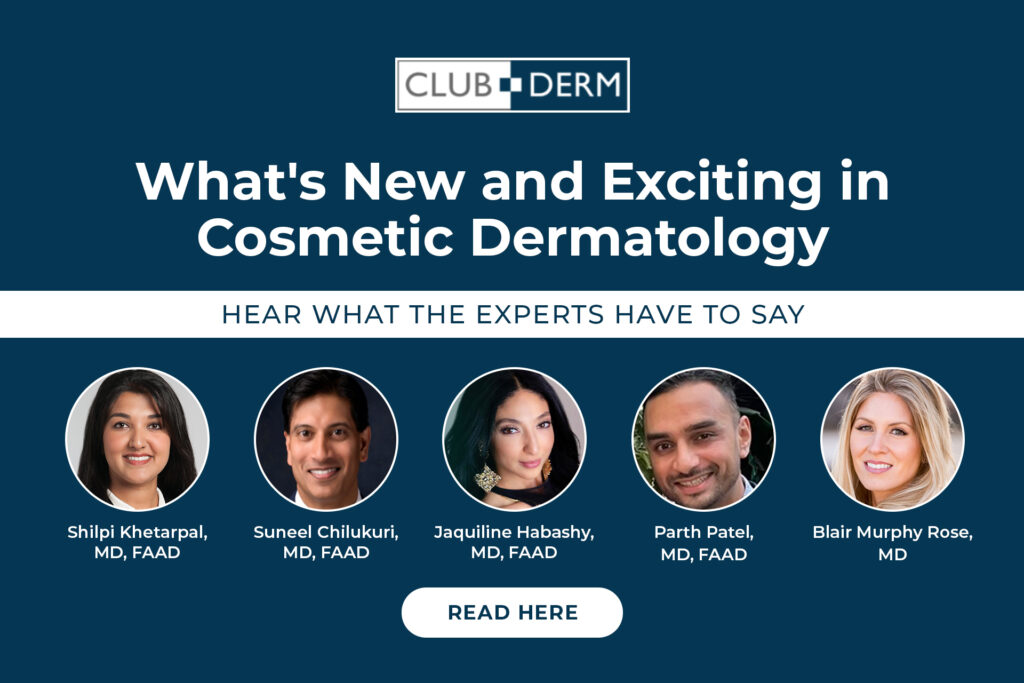Cosmetic dermatology is ever changing with the development of new treatment modalities and refinements to existing modalities. From lasers to injectables to topicals and more, dermatologists have a growing armamentarium of tools that can improve a patient’s look. Of all the latest developments in cosmetic dermatology, here’s what ClubDerm’s Advisors & Contributors are most excited about.
Exosomes and Regenerative Medicine
Coming in at the top of the list this year is the field of regenerative medicine, specifically exosomes.

“We have been talking about regenerative medicine for the last seven years, but it’s been largely ignored until last 12-18 months,” said Suneel Chilukuri, MD, FAAD. “The latest buzz word is exosomes, but we have been utilizing regenerative methods for almost four decades, including laser resurfacing, microneedling, radiofrequency and PRP, including the injection of autologous stem cells derived from one’s own fat. What’s really exciting is using the combination of energy-based devices with more efficient communication factors, which are exosomes and peptides. That combination is most exciting because we’re seeing more rapid results, decreased downtime and cumulative effects.”

“I believe there will be a rise in exosomes and skin boosters, which are often used in the international aesthetic space and are now entering the US market!” said Jaquiline Habashy, MD, FAAD. “Exosomes have been shown to improve wound healing, scars, and boost aesthetic treatments. Skin boosters on the other hand, are considered skin conditioning treatments, used to improve hydration and overall skin quality. They have been shown to be great as adjunct treatment to lasers and energy based devices, as well as stand-alone treatments.”

Parth Patel, MD, FAAD, is also focused on exosomes. “The ability of exosomes to carry bioactive molecules and promote cellular communication opens avenues for innovative skincare therapies. As research progresses, the incorporation of exosomes into dermatological interventions — whether it be topical or with laser-assisted delivery — may revolutionize the field of cosmetic dermatology and be a competitor to platelet rich plasma or other autologous stem-cell products.”
Dr. Chilukuri is also interested in other applications of regenerative medicine, including new methods of combating internal aging. “The advancements in wellness medicine will help all of us feel as young as we look on the inside.”.
Liquid Botulinum Toxin
Shilipi Khetarpal, MD, FAAD, is eager to use a new neurotoxin product.

“I’m most excited about a novel, ready to use liquid botulinum toxin A by Galderma, called RelabotulinumtoxinA. In the clinical studies, improvement was seen for up to 6 months in the glabella and lateral canthal regions. This would be a unique product to the U.S. market of neurotoxins as it has a rapid onset and long-lasting effect.”
Formaldehyde Ban
Blair Murphy Rose, MD, is attentive to patient safety in cosmetic products.

“I am thrilled that the FDA is moving forward (fingers crossed!) with a ban on formaldehyde and formaldehyde-releasers in hair straightening treatments this year. Our beauty and personal care industry is notoriously wrought with ingredients that simply do not belong on our skin, including this category of known carcinogens! Finally we are seeing one significant step in the right direction to protecting consumers. I wish it was more, but I am hopeful that this is just the beginning and that further important restrictions will come as this precedent is set.”
As the science of aging continues to be understood, cosmetic dermatologists will have even more available treatments and a greater understanding of how to enhance their effectiveness. In addition, science on the carcinogenicity of products will help dermatologists and regulatory bodies make better choices about which cosmetic products should remain in the market. Look for even more developments in this ever-evolving field in the year to come.
Author
-

Kim Campbell is the CEO of the Dermatology Authority, which provides Dermatologist’s career growth resources through a national job board, recruiting services, and practice start-up resources. They also coordinate educational seminars, speaker programs, webinars, board reviews and various other industry events. Kim started her career in dermatology launching the Ackerman Academy of Dermatopathology, which developed into a leadership role at Dermpath Diagnostics. She has her MA is Health Administration, with more than 20 years of experience in the business of Dermatology.
View all posts

